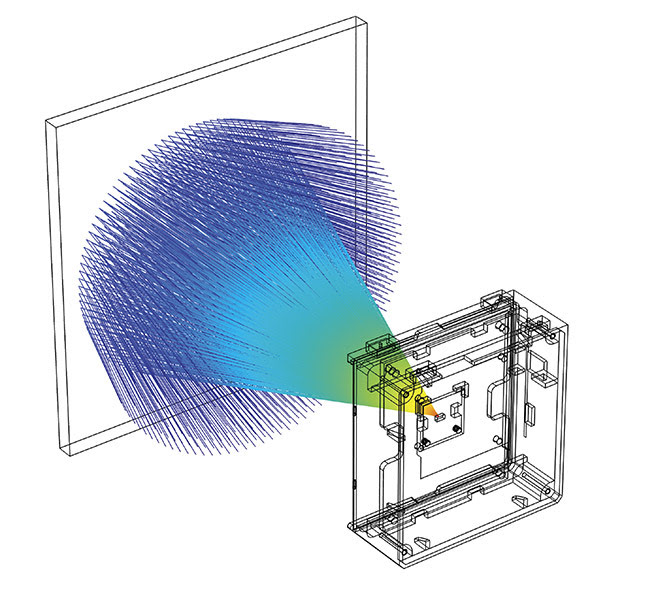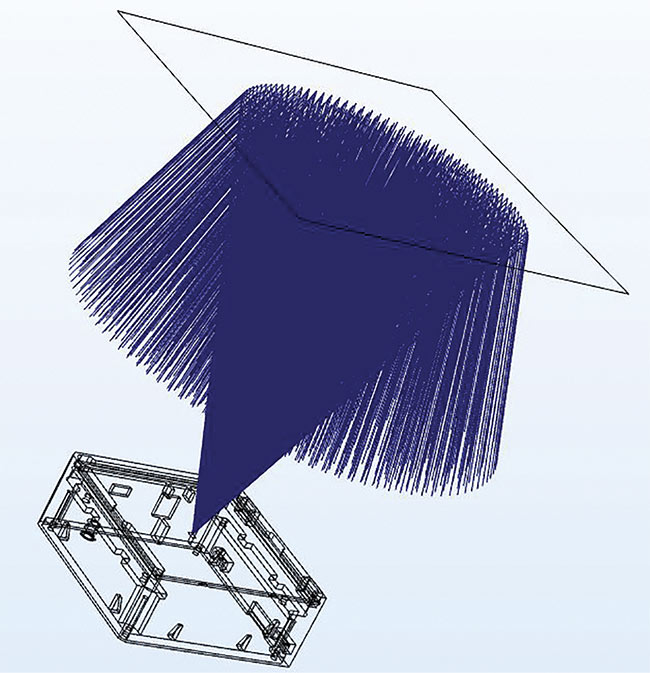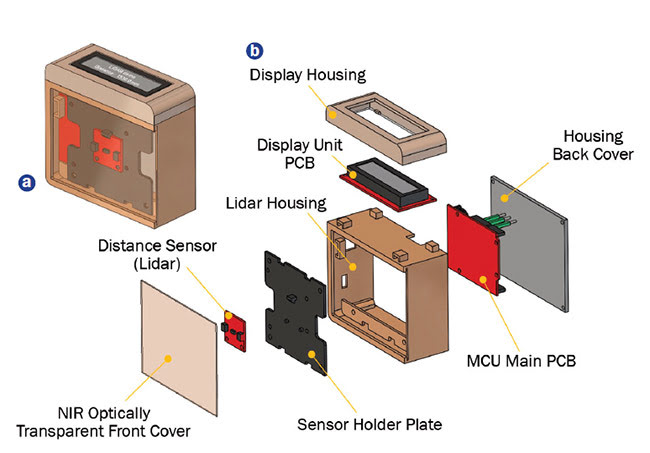Designers of today’s precision automotive lidar systems require seamless access to specialty polymer and metals data.
SOMASEKHAR BOBBA VENKAT, MARTIN SAS, AND SUBHRANSU MOHAPATRA, SABIC

A TOF illustration generated using COMSOL modeling software. Courtesy of SABIC.
Designing new automotive lidar systems is a complex process, made easier with access to finite element method simulation software and materials data. One of the key simulations performed is time of flight (TOF), a process that measures the laser light’s travel time to determine distance to an object. The distance is based on the time elapsed between emission of the signal or pulse and its return to the detector after being reflected by the object (Figure 1).

Figure 1. An illustration of the TOF process, generated using COMSOL modeling software. Courtesy of SABIC.
The accuracy of TOF measurements is essential to the performance of a lidar system so that it can reliably generate real-time data about the distance, size, and position of objects, and improve driver safety (Figure 2). Multiple factors can affect TOF, including the thermal resistance of the material used in the
front cover/lens of the assembly. The ambient temperature, combined with heat generated by the laser and adjacent electronics, can cause part deformation and a shift in the level of transmission at the specific laser wavelength being used. Very cold ambient temperatures can also degrade part geometry and material performance.

Figure 2. Simulation of lidar in use on the highway. Courtesy of SABIC.
Similarly, the other components of a lidar assembly — including electromagnetic interference (EMI) shielding, thermal conductivity, and dimensional stability of the sensor fixture and electronics housing — require specific material properties that enable optimized performance and durability. As the lidar system’s placement on vehicles evolves, material resistance to environmental factors such as moisture and road chemicals must be considered in simulations, too.
Because material properties and performance play important roles in designing individual lidar components and complete systems, designers need to factor them in early. Rather than rely on time-
consuming and costly prototyping tests with physical samples to select the best material candidates, designers prefer to use simulation software. The software, which includes key material data, can be used in the initial design phase to quickly narrow options. However, the lack of integration between the material suppliers’ databases and software simulation tools often requires the designer to manually enter materials data from technical datasheets into the software. This step is tedious and prone to errors.
Designers need easy access to detailed data on specialty materials such as thermoplastic resins and compounds. When materials libraries are digitally integrated with commonly used simulation software tools, time and money are saved. Candidate materials can be tested earlier in the design process, which enables increased confidence in the real-world performance of the chosen material under varying conditions.
Choosing the right materials
Today’s lidar assemblies typically
consist of the following: a protective, optically transparent front cover that
enables the laser light emitter and receiver to transmit wavelengths that are limited to eye-safe levels (within an NIR spectra of 905 to 1550 nm); a holder for the TOF measurement sensor; a printed circuit board (PCB) that processes the signal
and sends it to the main electronic control unit and takes corresponding actions; and the assembly housing (Figure 3). Each part has specific material performance requirements that are essential to the
accuracy, reliability, and durability of
the lidar system.

Figure 3. A generic CAD model of lidar, assembled (a) and exploded (b) views. MCU: microcontroller unit. Courtesy of SABIC.
Material requirements
Front cover
• High transparency and low refractive index to allow rapid pulses of laser light to pass through, bounce off an object, and return to the sensor.
• A stable refractive index for minimizing reflections.
• Abrasion resistance to protect against exposure to road debris.
• Thermal resistance to withstand
environmental temperature extremes.
• Ability to accommodate the heating
elements (defogging/defrosting) needed to maintain optical clarity.
• Dimensional stability to avoid part
deformation, which can affect the
sensor’s accuracy.
Optics fixture
• Dimensional stability and low
coefficient of thermal expansion.
• Heat resistance.
• Low optical reflectivity.
Housing
• Chemical, UV, and thermal resistance
to withstand environmental exposures.
• Dimensional stability to avoid part deformation.
• Low moisture uptake to avoid part degradation.
• EMI shielding to prevent external
interference with other electronics.
Sensor holder
• EMI shielding to prevent internal
interference with onboard electronics.
• Thermal conductivity for heat
dissipation.
• Dimensional stability.
In addition to meeting part-specific requirements, materials need to offer optimal design freedom and be lightweight to enable advancements in the size, fit, configuration, and positioning of assemblies. For instance, more and more OEMs embed lidar sensors within the front and rear fascia or within the headlights of vehicles. These areas are more susceptible to road debris, chemicals, and UV light.
In response, many designers are exploring the use of specialized thermoplastics to replace traditional glass, metal, and lower-performing plastics in lidar parts. Specialty thermoplastic resins and compounds deliver targeted functionality, such as integrated EMI shielding, thermal conductivity, high heat resistance, IR transparency, optical clarity, and chemical and abrasion resistance. They also expand design freedom and streamline processing.
Access to materials data
Designers who work with computer models of lidar sensors need to determine how a given material will perform during simulations of various use conditions. Although many simulation software tools include a library of data for generic materials such as glass and metals, designers who wish to run simulations with advanced engineering thermoplastics to identify promising new candidates have to request datasheets from suppliers. They then must manually enter data such as IR transparency and thermal resistance into the software, which, as mentioned earlier, is a time-consuming and error-prone task. It slows down the design process and discourages designers from conducting simulations with a full range of material options. Also, it’s very possible
that without digital data integration,
designers may be unaware of other options. Further, manual data entry adds complexity when replacing one material with another, a process that already requires fine-tuning of the part geometry to account for differences.
A key advantage of integrated, digital access to dedicated materials libraries is the availability of multiple data points capturing linear and nonlinear characteristics of specific properties. Usually, these are provided in tabular form, which can be transformed into functions.
Once the designer narrows down the list of possible materials based on simulation results, the next step may be the physical testing of samples, or building and testing a prototype part. However, as computer-aided engineering technology becomes more sophisticated and precise, designers are moving away from prototypes. This trend makes having accurate, up-to-date, and easily accessible materials data even more important.
Software integration
Some suppliers are able to provide materials data in formats suitable for importing into specific design and simulation software. These files are populated with required property values to help the designers with virtual prototyping studies before fixing on the finalized design that can then be physically manufactured and tested. Simulation tools may also provide designers with the option to contact the supplier with any questions or concerns regarding the data that is available at materials libraries. Interaction between lidar designers/developers and suppliers will enhance materials database management for lidar technology advancement.
Benefits for designers
Current and accurate materials data provides essential inputs for computer simulations side by side with initial and boundary conditions. The availability of data in the right format prevents delays and speeds up the iterative process of simulations required to fine-tune the numerical model. When experimental data delivers the desired level of accuracy to computer models, there is less need for costly physical prototyping. These virtual models also enable faster design modifications and validation. Further, easy access to comprehensive and precise materials data from the supplier allows lidar designers to have confidence in how polymers will perform in real-world applications and uses.
Meet the authors
Somasekhar Bobba Venkat is global automotive technical manager for NORYL resins at SABIC’s Specialties business in Detroit. He has more than 13 years of experience in the field of engineering thermoplastics and composites applications development.
Martin Sas, Ph.D., is lead scientist for applications technology at SABIC’s Specialties business. He leads activities for electrical applications of high-performance polymers. Previously, Sas held engineering positions in the automotive, semiconductor, and embedded systems industries, with a focus on sensors.
Subhransu Mohapatra is staff scientist for materials data at SABIC’s Specialties business.
He is responsible for improving quality, content, and access to materials data for SABIC’s specialty polymers. Mohapatra has 22 years of experience in engineering design and simulation in defense, automotive, aerospace, and heavy engineering.